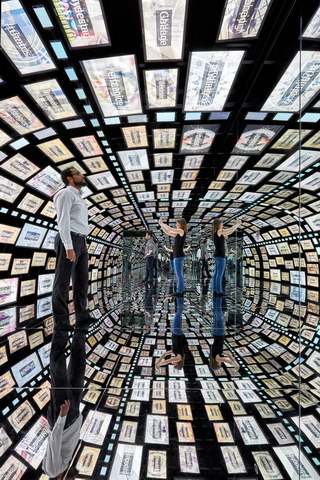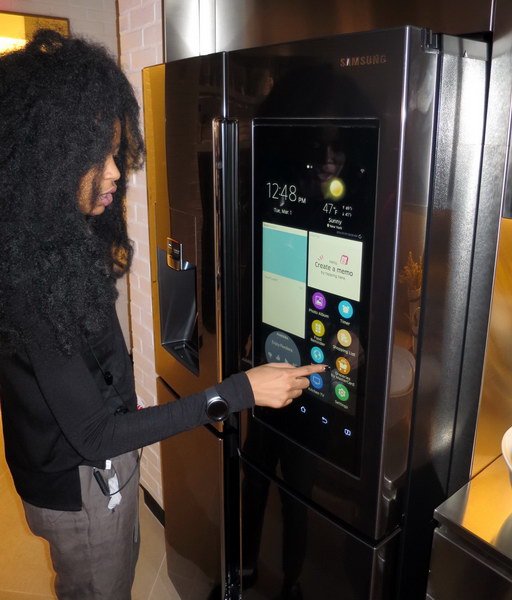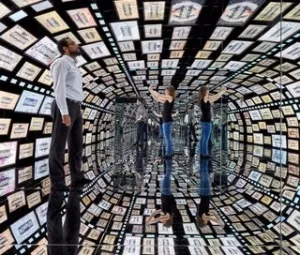Samsung 837 is a “Technology Playground” that opened on February 25th in the trendy Meatpacking District in New York. This three storey venue is intended to introduce Samsung consumer and B2B products to all comers. Except for the coffee and sandwiches, nothing was for sale – this was a demo space, not the Samsung equivalent of an Apple Store.

“We set out to build a marketing center of excellence,” said Gregory Lee, President and CEO of Samsung Electronics America. “We immediately thought of New York City, where the best marketing happens and where people have a finger on the pulse of culture. As a result, we have and will continue to attract top talent from around the world.”
Any exhibit like this is dominated by its displays and display-related applications. For example, there was an art installation called the Social Galaxy, designed for Samsung by Black Egg. This installation included displays from Samsung Galaxy S6’s, Note 5’s Galaxy Tab E’s, Galaxy Tab S2 8”s, Galaxy Tab S2 9.7”s, 32” LED monitors and 21.5” LED monitors. Mirrored walls and floor make it look like there are even more displays than there actually are. Social Galaxy captures your public Instagram account and shows all your posts on the various displays.
The installation description said in part, “In this two-part experience, screens capture your past, mirror your present, and project your vision of the future. They represent the synthesis of technology and identity, leading you through a mind-bending installation of your social identity and at last revealing a larger-than-life reflection of your social self on the Screen.
“Every thought you’ve had and authored, every moment you’ve captured and posted, ripple through the continuum of digital time and space. They intersect with the ripples of countless others. The Galaxy through which they travel is infinite.”
While I didn’t actually go inside the Samsung and Black Egg Social Galaxy (I don’t have an Instagram account), Emilia Petrarca did and described it as a “hyper-narcissism chamber.” Her closing comment was, “More likely though, you’ll realize that you take way too many selfies – one of which I made sure to snap before exiting.” You can read her full report at wmagazine.com. Social Galaxy from Samsung and Black Egg shows you your public virtual persona.
Social Galaxy from Samsung and Black Egg shows you your public virtual persona.
Samsung had its connected refrigerator, called the “Samsung Family Hub,” on display even though it is not yet available in the US. It had a large multi-purpose display on the door where you used to find children’s art and refrigerator magnets. The display was like a general purpose, oversize Android tablet you could use to send messages, retrieve menus, check the weather, etc. In addition, it had three cameras inside the refrigerator connected to it, one for each shelf. Get to the grocery store and wonder if you need milk? Look inside your refrigerator remotely using your smartphone to see what’s there.
 Samsung Family Hub connected Refrigerator
Samsung Family Hub connected Refrigerator
In a photo booth, Samsung had set up four smartphones, the LG G4, the iPhone 6, the Samsung S7 and the HTC Me. They took your picture and then compared the image generated by the S7 side-by-side with the phone closest to the one you own. The photo below shows the author and his wife shot on the S7 and the iPhone 6.
 Photo taken by the Galaxy S7 compared to the iPhone 6 (Click for original, full resolution version)
Photo taken by the Galaxy S7 compared to the iPhone 6 (Click for original, full resolution version)
The original, full resolution image was e-mailed to me direct from Samsung
There were three VR exhibits at Samsung 837, all based on the Galaxy S6 with the Gear VR headset as the phone holder. I tried two of the demos and, unfortunately, both demos were less than impressive. The Galaxy S6 with 2560 x 1440 resolution simply didn’t have enough resolution for a VR system. I’ve been underwhelmed by VR demos on this resolution issue before but I always wondered if it was because the phone display didn’t have enough resolution. I now consider that argument settled – the Galaxy S6 with 576 PPI is as high a resolution a smart phone you are likely to see and it still didn’t have enough resolution. Going forward, the S7 will have the same 2,560 x 1,440 resolution and 576 PPI when shipments start in a couple of weeks so it won’t be any better for VR, at least not in terms of resolution. (Note – in its suite at CES, Samsung Display was showing an 800+ ppi OLED designed for headset applications – Man. Ed.)
 Author looking down and to the side to see a fish swimming by
Author looking down and to the side to see a fish swimming by
In addition, the Gear VR optics showed noticeable chromatic aberration and distortion, further distracting from the non-immersive VR experience. Plus the content was poorly chosen: one of the VR exhibits showed three animated fish videos and the other had static images of the night sky at Natural Bridges National Monument. AM-OLED displays, such as the one used in the Galaxy S6, are supposed to have high contrast, but it still wasn’t high enough to show a convincing night sky. None of the content shown had any interactivity.
Operating the Samsung VR system was not intuitive. While I finally got it to work, my wife couldn’t see the VR images, even with the help of the Samsung guide. She got to the “Loading” screen, but somehow the content never finished loading and she didn’t see it played. Perhaps the non-intuitive interface won’t affect owners and end users of the Gear VR headset but for a place like Samsung 837 where most viewers will be first-time VR users, I consider this a major problem.
This is intended to be a permanent, not a “pop-up” venue. Clearly Samsung has spent a lot of money on Samsung 837. (The name comes from its address, 837 Washington Street, in Manhattan.) The clear focus of the place was on interactivity. While there were two Samsung TVs there, it wasn’t even clear if they were showing FHD or UHD content. A video wall consisting of an 8 x 12 array of tiled LCD signage displays was nice and Samsung says it will be used to show movies such as The Martian. The mullions between the adjacent displays are likely to distract from that, although they did not affect the interactive application the screen was used for while I was there.
In a separate installation of Samsung touch screen digital signage screens, the touch didn’t seem very user friendly. Maybe that’s my fault since I only occasionally use touch screens. Considering the touch screen signage was showing information on Samsung’s refrigerators, washers and driers, the information was surprisingly incomplete and difficult to access.
Perhaps the centerpiece of the venue was a couple of tables full of Samsung tablets and smartphones, including the Galaxy S7 and S7 edge, for visitors to try and play with. Samsung was also providing technical support for current product owners.
Overall, Samsung 837 was trendy – very trendy. A showcase for Samsung displays and other technology? Not so good.
– Matthew Brennesholtz

